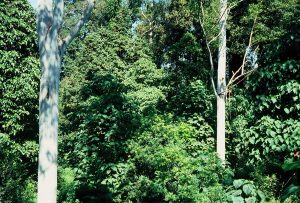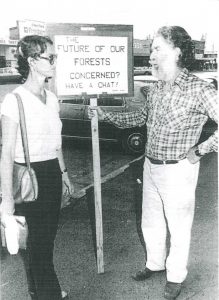We asked Wingham resident, John Stockard, a member of the original team who fought to restore the Wingham Brush, and pioneered a world first in rainforest regeneration, known as the Wingham Brush Method, for the background story.
Wingham Brush Nature Reserve is the site of the first formal attempt to restore a rainforest. Prior to 1980, the forest canopy was blanketed in South American Vines and the forest floor smothered in a metre-thick cover of weeds, completely unrecognisable from how it appears today.


The Brush was unrecogniable back then, smothered in walls of hillocks of weeds, all of the vegetation we see now was hard won, battling frosts and floods.
The restoration work resembled an archaeological dig at times, with bent saplings, just holding on, freed from these aggressive vines with secateurs and brush-hooks so they could stand up again and grow. Some of the vines had extensive root systems with massive tubers and long pods of winged seeds. Others didn’t seed but produced thousands of tubers along their stems, each of which, falling down, started another vine which could grow over a metre a week in the summer.
The local team (See photo) developed a method for restoring degraded rainforest, pioneering careful herbicide techniques. This is now known worldwide as The Wingham Brush Method and has been used in saving many other invaluable remnant rainforests. Often only small pieces are left of once extensive stands, and the pace of rainforest clearance worldwide continues this fragmentation.
The irreplaceable Wingham Brush represents about a tenth of its type left in NSW. This type of rainforest, the most complex ecological community in NSW, is at its southern limit on the Manning, and once covered most of our well-drained river flats up to Mount George. Only Wingham Brush and Coocumbac Island remain of the many thousands of hectares which were cleared and burnt for agriculture; together they are the only representatives of their type along 400 kms. of coastline.

Our Identity
Wingham Brush Nature Reserve is the cornerstone of the town’s identity. Not everyone knows that our town’s name, in keeping with the policy of using Aboriginal place names by the surveyors at that time, derives from the Kattang word “wingan”, meaning “a place where bats drink”. This refers to the habit of flying-foxes swooping down, dipping into the river on hot days, roosting and then licking the water from their fur.
The name Wingham thus represents an outstanding landscape continuity stretching back countless thousands of years and this continuity is only made possible by the remnant forest of Wingham Brush, a threatened ecological community, being in turn a major maternity site for the also threatened Grey-headed Flying Fox.
Despite shameful and barbaric attempts to exterminate our town’s namesake with organised shoots spanning 70 years, and a history of misusing and abusing our Brush, both battle on today against overwhelming odds. It is purely accidental that a village in Kent shares our town’s name.
Passed over as doomed to extinction, the Wingham Brush was finally restored by a Herculean effort from a small group of persistent locals over 20 years. The team’s work was the subject of the first scientific assessment, spanning five years, of an ecological restoration program, culminating in the gazettal of Wingham Brush as a NPWS Nature Reserve in 2000. Wingham Brush is considered an icon in ecological restoration.
Needs Care
The precious Wingham Brush requires continual care and maintenance as it is very prone to reinfestation from a wide range of aggressive weeds, including the very weeds which had overwhelmed it and remain untreated within the catchment, washing down in floods. The Brush continues to be vulnerable to abuse and misuse by humans, not only deliberately from vandalism, but also from ignorance.
John Stockard

6 Comments
Wingham Brush, as stated by John Stockard, is the most recognisable and well known feature of our town. The efforts of the Wingham Brush Restoration team over many years has ensured that this rare example of rainforest has survived. The introduction of “free camping”, and all that this practice brings, would seem to me to be a retrograde step. Any benefit that may be gained by the local business operators of Wingham would, I suggest, be outweighed by the potential degredation of the Wingham Brush and surrrounding area. Apart from grocery items and fuel, there would be few businesses which would likely benefit from permitting “free parking” in the Wingham Brush area. We, as a community, should all question the proposal to further “develop” the Wingham Brush area however well meaning the plans of WAG may be. Tony Ryan 6 Rosella Dr, Wingham. Mob: 0427 712294
My husband and I recently stayed at the ‘free camping’ site between Wingham Brush Reserve and the Manning River. We don’t want to interfere in a matter that is for the local townspeople to decide, but do wish to put forward the following remarks thank may assist in your town’s considerations of what is best for the Reserve and the community.
A free-camping or cheap-camping site either where it is or maybe nearby, developed to encourage travellers to Wingham.
This particular camp site is far and away the most unique we have encountered and we absolutely loved it and would like to return again in the future.
During our stay we were respectful of the whole area (as we saw others were too) and put donations in the box provided every time we stayed. We were amazed at the number of (presumably) local people using the area (one came to put his two bags of rubbish into the bin in time for the garbage collector), arriving by foot or vehicle, way, way, in excess of the number of people who stayed overnight. It is a surprisingly busy area. We stayed one night and then returned later for another couple of nights – the area was so beautiful. Like many travellers we have met on the road, when there is opportunity to camp cheaply, we make a point of supporting the local community and in this case, spent money buying groceries, fuel, magazine and newspaper at the newsagent, purchased at McKeough’s cake shop too many times for our waistline, and had dinner in town.
A suggestion we would make is a donation box at the entrance(s) to the reserve with mention of the need for funds for the ongoing important work.
I cannot believe that people still think that humans are respectful of natural areas without heavy legislation. Regardless of how pleasant a stay being near Wingham Brush might be for some people, if a camping site is situated anywhere near this area there will incremental if not sudden damage. I am amazed by the comment above: ‘We were amazed at the number of (presumably) local people using the area (one came to put his two bags of rubbish into the bin in time for the garbage collector … as if they think this is a good thing ! For each person putting it in the bin there will be multiple who won’t. And as far as the economic arguments goes, people can stay in Wingham in multiple places cheaply and buy their supplies locally without having going to camp in the immediate vicinity of an endangered ecological community.
When will human focused people realise that Australia leads the world in mammalian extinction and is a MAJOR world leader if extinction generally?
When will the ‘progress’, ‘development’, everything for human comfort mentality end? Oh, I know, when all is lost.
My my Frances. What an attack. Just how did you suppose I am human focussed? And you mis-read me when you say I thought that local people putting their garbage in the bins at the site was a good thing! I thought it was an abuse of the rubbish system and was trying to point out that you can’t blame visitors to Wingham for all problems there. I witnessed cars driving off the road area and through the grass mound that were not campers. I suggest more damage to the area by locals than visitors. I would be interested to know why the boardwalk was put in place if Wingham didn’t want visitors to see through the reserve. Just how was parking a fully self-contained motorhome harm to the area? Perhaps you would like the whole area cordoned off with access by no-one? Me thinks you are a little over the top.
There is already very heavy local usage and often congestion in this area, as the Humbles observed. And wherever there are lots of people, there are problems. And Lee is right about cars driving on the grass mound and right up alongside the Brush. Somehow, despite the Plan of Management years ago recommending a buffer for the Brush with bollards, this has never been put in place here but, instead, was put on the other side of the road for the grassed area there. The problem with camping is that it attracts all sorts of non-self-contained campers as well as responsible people like the Humbles. There just isn’t the room for a camping ground here and the reserve is small and an endangered ecological community. Frances is correct about the immediate and incremental negative impact of camping here. The NPWS have provided an excellent raised walkway to encourage day-use tourism. The Brush is the lower Manning’s top tourist attraction. Of course we want to attract tourists, and we want to encourage the self-contained RV market to Winghan, but this small and very sensitive area is just not the place for campers. I hope Lee can appreciate the wider issues here and the challenges that Wingham Brush faces.
Thank you John for your response. I hope Wingham can find a solution to promoting tourists to your town, perhaps at an alternate location, as we would love to come back again. Everyone we encountered were very friendly and as you already know, a beautiful place.